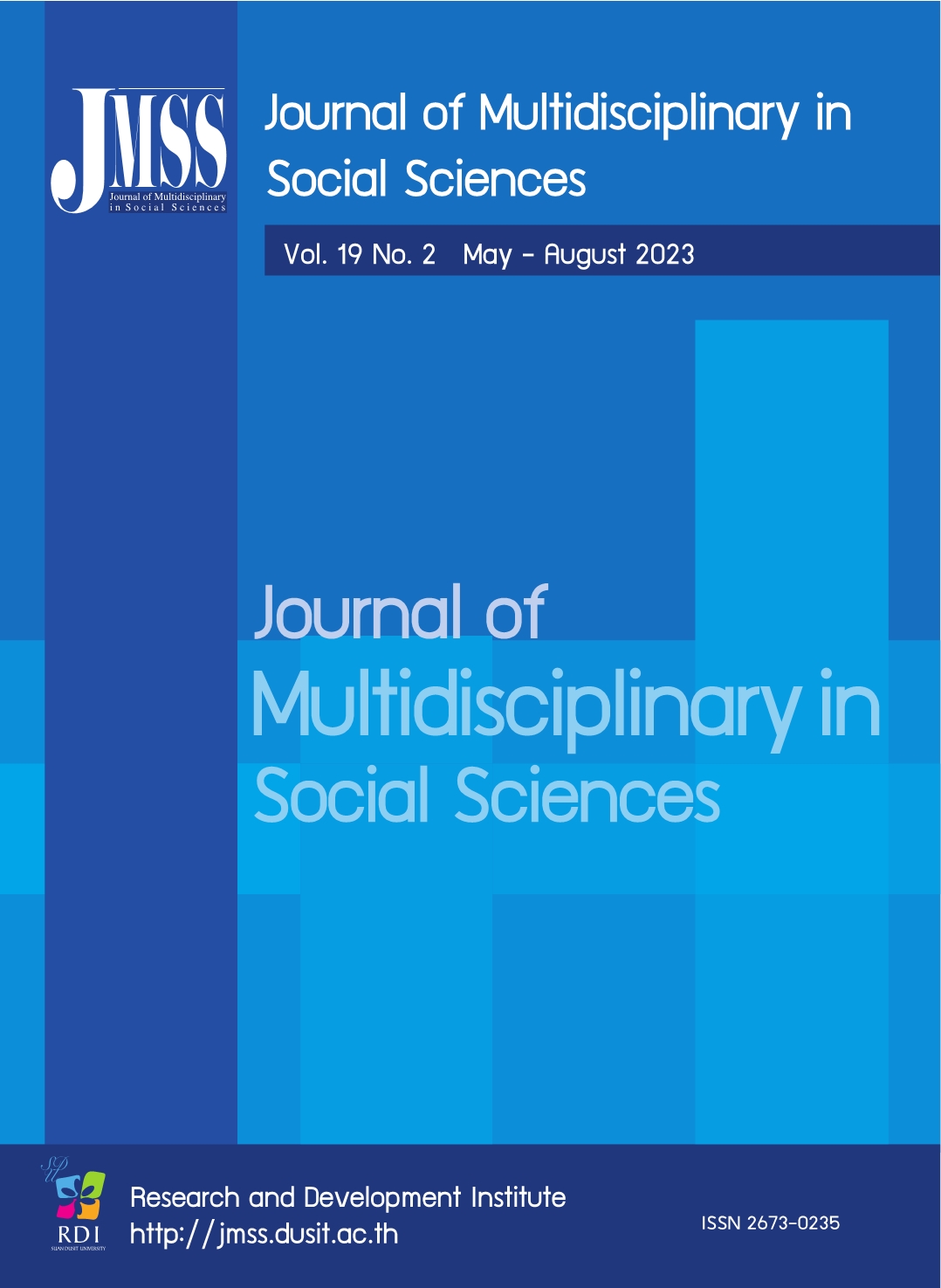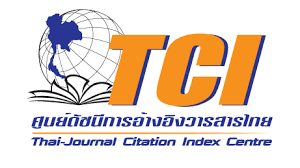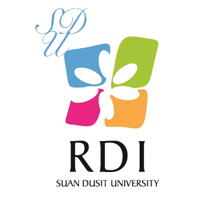Teachers’ and Students’ Perceptions towards the Use of Translanguaging in English Language Classrooms in Thailand
Keywords:
Mixed method, Native English teachers, Perceptions, Secondary levelThai students, TranslanguagingAbstract
This research focuses on secondary school teachers’ and students’ perceptions towards the use of translanguaging in English language classrooms in Thailand. The research questions are: 1. What are secondary level students’ perceptions towards the use of translanguaging in English language classrooms? 2. What are native English speaker teachers’ perceptions towards the use of translanguaging by secondary level students in English language classrooms? The participants were 363 Thai students and 9 native English speaker teachers. The 363 Thai students who were in secondary level 1, 2, and 3 (equivalent to grade 7, 8, and 9, respectively) were requested to complete the online questionnaire. To obtain qualitative data, nine Thai students and six native English speaker teachers were requested to participate in the online text-based interview. A mixed method approach was used in this study. The instrument for collecting quantitative data was an online 5-Likert scale questionnaire whereas the instrument for collecting qualitative data was an online text-based interview. According to the findings, both Thai students and native English speaker teachers had positive perceptions towards the use of translanguaging in English language classrooms. In addition, translanguaging helped students to understand complex lessons and improve their English communication skills. However, students did not use the native language to respond to the teacher’s questions or ask permission from the teacher very often. The research recommends that teachers implement translanguaging to enhance their English teaching effectiveness, and students were suggested to use translanguaging to enhance their English learning competency.
References
Anouk, T., Elma, B., Paul, L. & Sarah, M. (2021). Translanguaging Challenges in Multilingual Classrooms: Scholar, Teacher and Student Perspectives. International Journal of Multilingualism, 18(3), 491-514.
Baker, C. (2001). Foundations of Bilingual Education and Bilingualism (3rd ed.). Toronto, CA: Multilingual Matters.
Bartolomé, L.I. (2016). Bilingualism. In G. Ritzer (Ed.), The Blackwell Encyclopedia of Sociology. Retrieved from https://doi.org/10.1002/978140 5165518.wbeosb021.pub2
Bolton, K. (2018). World Englishes and Second Language Acquisition. World Englishes, 37(1), 5-18.
Cain, A.A. (2018). Seven Tips for Teachers of Newcomer Emergent Bilingual Students. The Reading Teacher, 71(4), 485–490.
Caldas, B. (2019). To Switch or not to Switch: Bilingual Preservice Teachers and Translanguaging in Teaching and Learning. TESOL Journal, 10(4), 485.
Castaño, H. M. (2017). English Language Learners' Perceptions of Translanguaging as An Instructional Method: A case study (Doctoral dissertation). Retrieved from ProQuest Dissertations & Theses database. (UMI No. 10685492).
Cenoz, J., & Gorter, D. (2019), Multilingualism, Translanguaging, and Minority Languages in SLA. The Modern Language Journal, 103(S1), 130-135.
Choklap, R. (2015). The Experiences of Native Speaking Teachers (NSTs) When Teaching English as A Second Language to Students (ESLs) in Thailand (Doctoral dissertation). Retrieved from ProQuest Dissertations & Theses database. (UMI No. 3703518).
Cohen, L., Manion, L., & Morrison, K. (2018). Research Methods in Education (Eighth edition). New York: Routledge.
Cook, V. (2001). Using the First Language in the Classroom. Canadian Modern Language Review, 57(3), 402-423.
Darasawang, P. (2007). English Language Teaching and Education in Thailand: A Decade of Change. In N. D. Prescott (Ed.), English in Southeast Asia: Varieties, literacies and literatures. Cambridge: Cambridge Scholars Publishing.
Denscombe, M. (2014) The Good Research Guide (fourth edition). Maidenhead: Open University Press.
Escobar, F. C. (2019). Translanguaging by Design in EFL Classrooms. Classroom Discourse, 10(3-4), 290-305.
García, O., & Kleyn, T. (2016). Translanguaging with Multilingual Students: Learning from Classroom Moments. New York: Routledge.
García, O., & Wei, L. (2020). Translanguaging. In Chapelle, C.A. (Ed.), The Encyclopedia of Applied Linguistics. Retrieved from https://doi.org/10.1002/9781405198431.wbeal1488
Jenks, C., & Lee, JW. (2020). Translanguaging and World Englishes. World Englishes, 39(2), 218-221.
Kampittayakul, T. (2019). The Role of Translanguaging in Improving Thai Learners’ Interactional Competence in Dyadic “English as a Foreign Language” Tutorial Sessions. Journal of Language Teaching and Learning in Thailand, 56, 80-111.
Kitjaroonchai, T. (2019). Perceptions of Students towards the Use of Thai in English Classrooms. CATALYST, Journal of the Institute for Interdisciplinary Studies. 13(1), 15 – 27.
Laksanasut, S. (2020). Bilingual Education in Thailand: Background, Implementation, Limitation, and Case Study. Office of the Education Council Journal, 17, 54-59.
Laoriandee, W. (2014). The ASEAN Community Establishment and the English Higher Education in Thailand: A Case Study of Chulalongkorn University Language Institute (Doctoral dissertation). Retrieved from ProQuest Dissertations & Theses database. (UMI No. 3669430).
Lopez, A.A., Turkan, S. & Guzman-Orth, D. (2017), Conceptualizing the Use of Translanguaging in Initial Content Assessments for Newly Arrived Emergent Bilingual Students. ETS Research Report Series, 2017(1).1-12.
Mbirimi-Hungwe, V. (2019). Stepping beyond Linguistic Boundaries in Multilingual Science Education: Lecturer’s Perceptions of the Use of Translanguaging. Southern African Linguistics and Applied Language Studies, 37(1), 15-26.
Nambisan, K. (2014). Teachers' Attitudes towards and Uses of Translanguaging in English Language Classrooms in Iowa (Master’s thesis). Retrieved from ProQuest Dissertations & Theses database. (UMI No. 1584648).
Nonthaisong, K. (2015). The Impact of the English Language Policy in the Basic Education Core Curriculum B.E. 2551(A.D. 2008) on English Instruction of Thai Secondary EFL Teachers: A Multiple Case Study in Northeast Thailand (Doctoral dissertation). Retrieved from ProQuest Dissertations & Theses database. (UMI No. 3726116).
Mujiono. (2016). Code Switching in English Instruction and Factors Affecting the Language Attitude of Indonesian EFL Learners in Using It. International Journal of Social Sciences & Educational Studies, 2(4), 12-24.
Ortega, Y. (2019). “Teacher, ¿Puedo hablar en español?” A Reflection on Plurilingualism and Translanguaging Practices in EFL. Profile, 21(2), 155-170.
Osorio, S.L. (2020). Building Culturally and Linguistically Sustaining Spaces for Emergent Bilinguals: Using Read-Alouds to Promote Translanguaging. The Reading Teacher, 74(2), 127-135.
Pechapan-Hammond, S. (2020). English in Thailand. In Bolton, K., Botha, W. & Kirkpatrick, A. (Eds.), The Handbook of Asian Englishes. doi:10.1002/9781118791882.ch27
Rebecca, D. S., Patrick, P. C., Jefferey. R., Doyle, B., Marisa A., & Anna, G. (2013). Teachers' Instruction and Students' Vocabulary and Comprehension: An Exploratory Study with English Monolingual and Spanish–English Bilingual Students in Grades 3-5. Reading Research Quarterly, 49(1), 31-60.
Relyea, J.E., & Amendum, S.J. (2020), English Reading Growth in Spanish-Speaking Bilingual Students: Moderating Effect of English Proficiency on Cross-Linguistic Influence. Child Dev, 91(4), 1150-1165.
Richards, J. C. (2015). Key Issues in Language Teaching. Cambridge: Cambridge University Press.
Rovinelli, R.J., & Hambleton, R.K. (1977). On the Use of Content Specialists in the Assessment of Criterionreferenced Test Item Validity. Dutch Journal of Educational Research, 2(2), 49-60.
Rowe, L.W. (2018). Say It in Your Language: Supporting Translanguaging in Multilingual Classes. The Reading Teacher, 72(1), 31-38. Safargalina, A. (2018). Teaching Speaking in EFL Environments. The TESOL Encyclopedia of English Language Teaching. Retrieved from https://doi.org/10.1002/9781 118784235.eelt0699
Saisoonthornwatthana, M., & Saengboon, S. (2016). A Qualitative Case Study of English Tutorial School in Thailand: Teachers’ and Students’ Perceptions. Language Education and Acquisition Research Network, 9(2), 68-82.
Suárez, E. (2020). “Estoy Explorando Science”: Emergent Bilingual Students Problematizing Electrical Phenomena through Translanguaging. Science Education. 104(5), 791-826.
Wang, D. (2019). Translanguaging in Chinese Foreign Language Classrooms: Students and Teachers’ Attitudes and Practices, International Journal of Bilingual Education and Bilingualism, 22(2), 138-149
Wang, J. (2018). Qualitative Research in English Language Teaching and Learning. Indonesian EFL Journal: Journal of ELT, Linguistics, and Literature. 4(2), 116-132.
Wei, L. (2020). Bilingualism and Multilingualism. In Stanlaw, J. (Ed.), The International Encyclopedia of Linguistic Anthropology. Retrieved from https://doi.org/10.1002/9781118786093.iela0034
Wongboonsin, P. (2006). Current Educational Reform in Thailand. Thailand Monitor.
Downloads
Published
How to Cite
Issue
Section
License

This work is licensed under a Creative Commons Attribution-NonCommercial-NoDerivatives 4.0 International License.








